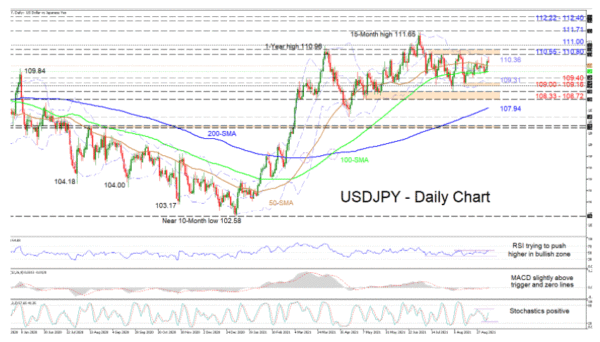USDJPY has shoved above the 50-day simple moving average (SMA) in attempts to head towards the ceiling of a three-week consolidation established between the limits of 108.72 and 110.80. The rising 200-day SMA is backing the positive picture, while the fairly sideways demeanour of the 50- and 100-day SMAs, is sponsoring a more horizontal price trajectory.
The short-term oscillators are reflecting an increase in positive momentum. The MACD has nudged above its red trigger and zero lines, while the RSI is fighting to make additional progress in the bullish zone. The positively charged stochastic oscillator is promoting extra upside price action, which would be confirmed with a break of the %K line above the previous high in the indicator.
If buyers continue to push higher, initial upside obstruction could commence from the upper Bollinger band at 110.36 ahead of the resistance ceiling of 110.55-110.80, which began forming from mid-to-end of July. A successful climb above the roof of the range and past the neighbouring 111.00 handle may propel the pair to challenge the 15-month high of 111.65, and the adjacent 111.71 rally peak of March 2020. Clearing this too could cheer the bulls to float the price towards the resistance section of 112.22-112.40, moulded between the rally peaks of February 2020 and April 2019 respectively.
Otherwise, if sellers steer the price back down, a tough preliminary support region could develop between the 50- and 100-day SMAs at 110.00 and 109.73. Dipping beneath this zone, the price may meet the 109.40 obstacle and the lower Bollinger band at 109.31. Should selling interest persist, the nearby 109.00-109.16 support belt could attempt to halt the price from sinking towards the support base of 108.33-108.72.
Summarizing, USDJPY appears to be restrained between the limits of 108.72 and 110.80. A break either below or above these mentioned boundaries could set a more decisive price direction into place.














